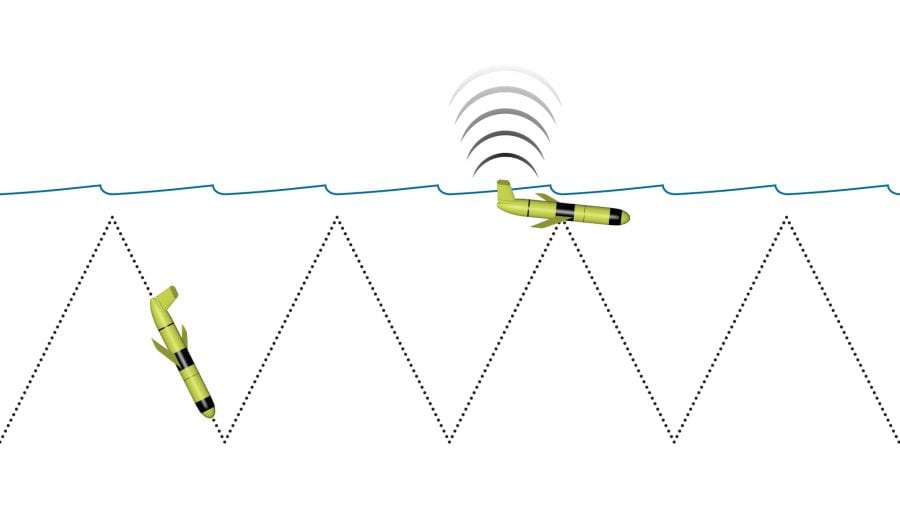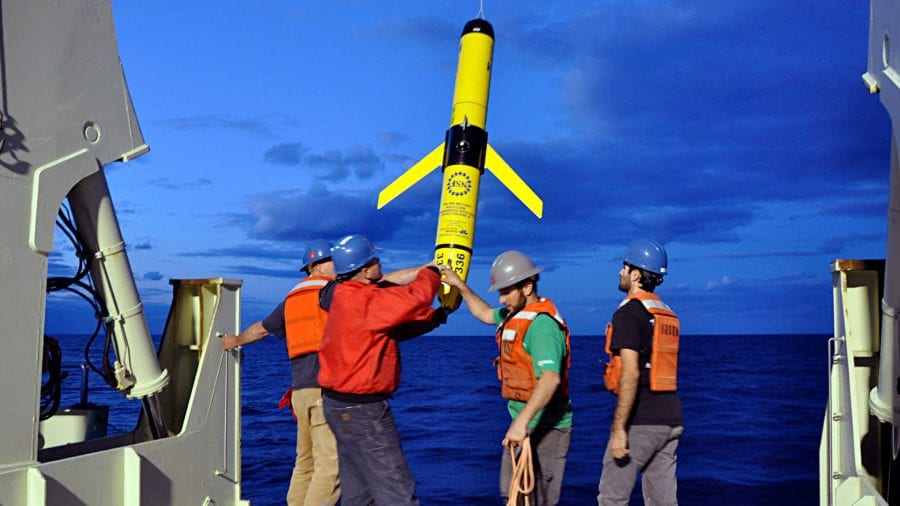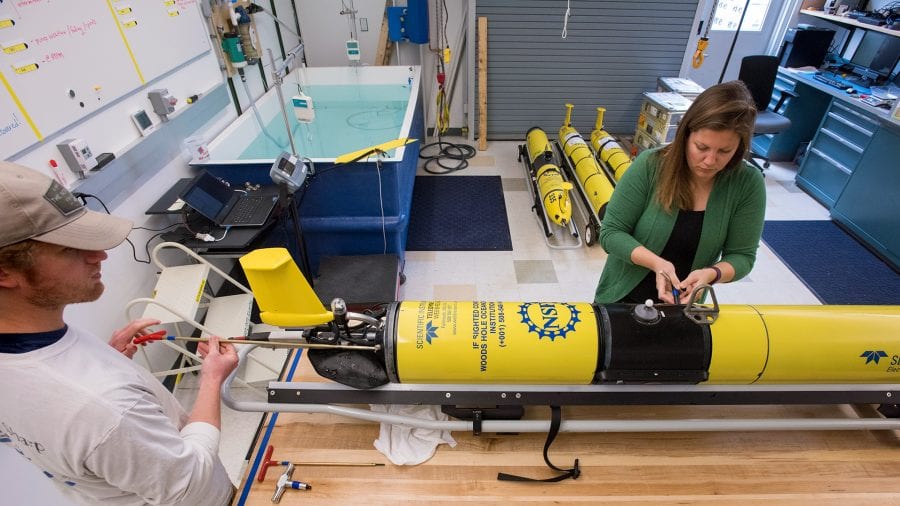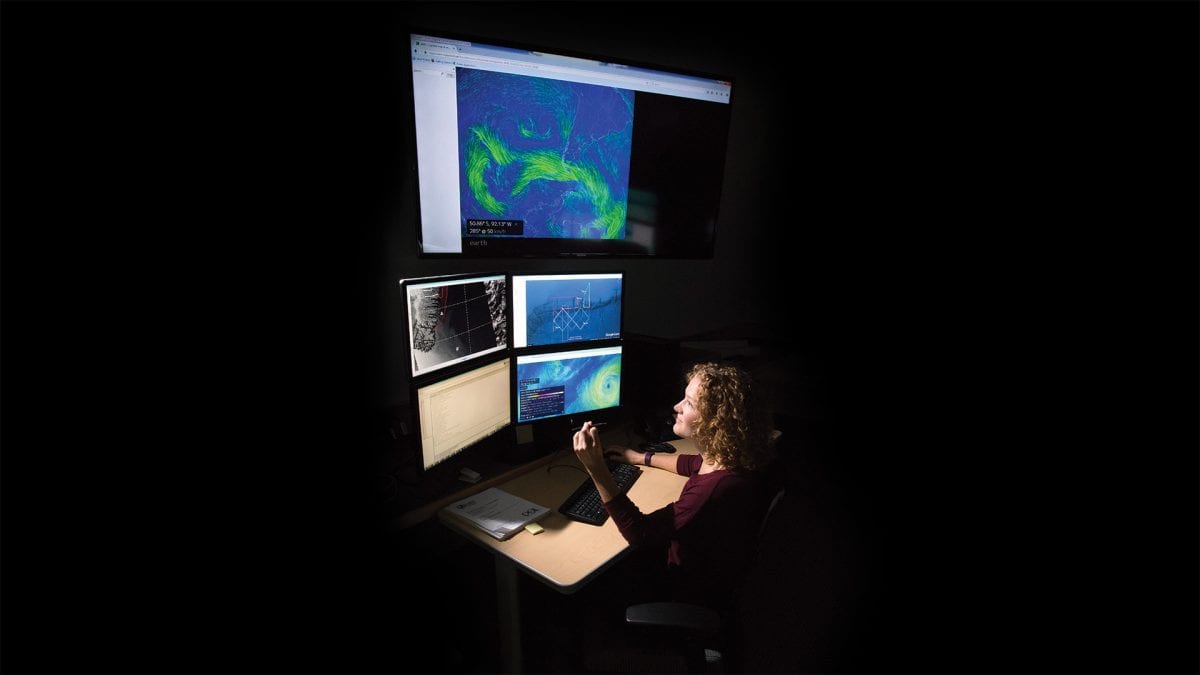
Diving for Data
Ocean Gliders and Their Pilots Are Helping Scientists Understand the Sea
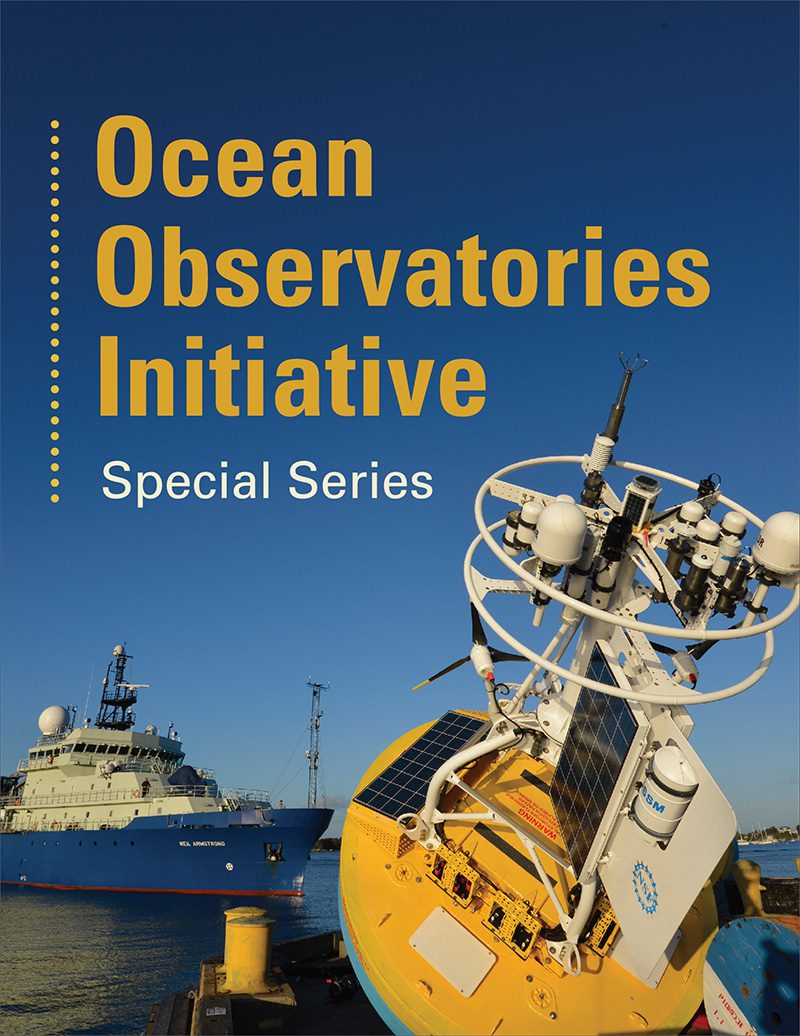 It’s the middle of the night on Cape Cod, Mass.
It’s the middle of the night on Cape Cod, Mass.
Thousands of miles away in the South Atlantic off the coast of Argentina, a bright yellow torpedo-shaped drone floats up from the deep ocean and emerges at the water’s surface.
Pummeled by wind and waves, the driverless underwater vehicle—an ocean glider—tips forward to raise its tailfin farther out of the water. Inside, a satellite antenna gets a GPS fix on the vehicle’s position and sends out a call.
Moments later back in Massachusetts, cell phones light up, blaring their alert tones: A glider needs help. For Woods Hole Oceanographic Institution glider pilots Peter Brickley, Diana Wickman, and Christina Haskins, it’s time to wake up and get to work.
Science that never sleeps
This “drone” doesn’t belong to the military—it’s in the service of oceanography: specifically, the Ocean Observatories Initiative (OOI), a large-scale, long-term data-collection project funded by the National Science Foundation.
The OOI’s infrastructure consists of several mooring arrays, two propeller-driven autonomous underwater vehicles, and the United States’ second-largest fleet of ocean gliders after the Navy’s. Operating at distinct locations in the Atlantic and Pacific Oceans, the moorings and underwater vehicles are outfitted with instruments and sensors to collect unprecedented data on ocean currents and chemistry, marine life, and Earth’s changing climate.
WHOI’s gliders patrol the OOI’s Pioneer Array about 90 miles off the New England coast. They also have been dispatched to remote, high-latitude Global Arrays near Alaska, Greenland, Argentina, and Chile. WHOI’s glider pilots oversee a total of 64 OOI gliders, with as many as 26 vehicles in the water at one time: five at each Global Array and six more at the Pioneer Array.
Before they hit the water, the gliders are programmed with their missions, including a series of waypoints laying out the path each one is to follow. Many traverse vast swaths of ocean and can dive to depths of nearly 3,300 feet. They carry a payload of scientific sensors to collect data on a variety of ocean properties for the scientific community.
Brickley, a senior engineer who leads the operations team that oversees WHOI’s OOI gliders, says the vehicles’ endurance is one of their greatest strengths.
“They never sleep, they don’t get tired, they don’t need to come in every three weeks and refuel,” he said. “So it’s a very efficient and effective way to get data.”
Flying from afar
But even “autonomous” underwater vehicles need a lot of supervision, when you’re trying to keep them going for months at time in an often hostile ocean.
Keeping tabs on a fleet of gliders at very different locations has its challenges. The pilots can’t see their vehicles or physically interact with them. And while a glider is submerged, there’s no way for pilots back at WHOI to find out exactly where it is or how it’s doing, because satellite communications don’t work under water.
A glider has only a magnetic compass, an altimeter, and dead reckoning to guide it until it comes back to the surface to get a GPS fix. Then it literally “phones home”—calling over the Iridium satellite service, the same system that allows people to make calls from remote locations with no cell phone service.
The glider’s call is relayed in near-real time to a computer in glider mission control: the Coleman and Susan Burke Operations Room at WHOI. A software program sounds a bell-like alert tone and announces the surfacing glider’s name: “cp387” for one of the gliders at the coastal Pioneer Array, for example. One of about a dozen computer screens lining the walls of the operations room springs to life, and line after line of codelike text scrolls by: the “conversation” between gliders and pilots. Another screen displays a map crisscrossed with yellow glider tracks; still another, the jagged red plot of one glider’s V-shaped dives.
But the pilots don’t need to be in the operations room to monitor the gliders’ progress.
“Anywhere you can have a laptop and an internet connection, you can ‘fly’ a glider,” said Wickman, a former Air Force satellite communications technician. “Usually after hours, pilots are flying the gliders at home, from their couch somewhere, or from their desk. We give them commands and send them on their way.”
Once a glider has surfaced, a pilot can use the two-way Iridium connection to send the vehicle instructions: a new sampling plan, new destination waypoints, or new “yo” files—the software scripts that tell a glider how deeply to dive. The glider, in turn, responds to the pilot, sending its position, its remaining battery life, and a small subset of its engineering and science data—only a small subset, because making an Iridium call takes a lot of battery power.
To conserve the gliders’ energy, the pilots try to keep them on the surface for less than 15 minutes. As a result, most of the data a glider collects are stored in onboard memory to be downloaded after the vehicle is recovered and brought back to WHOI for maintenance.
Launch in the darkness
The OOI gliders are almost always launched from a research ship—often at night, to accommodate other ship operations that need to happen in the daytime. A glider is equipped with a strobe light, making it easier for the ship’s captain and crew to see the relatively small vehicle once it’s in the water.
“You have to make sure the boat knows where the gliders are,” said Haskins, who has been piloting ocean gliders for eight years. “A lot of times, deployments might happen at midnight. They might happen at 2 a.m.” For the glider pilots back at WHOI—or on their laptops at home—that can mean piloting throughout the night, sometimes for several days in a row, depending on how many gliders are being launched.
“Deployments typically are all-nighters,” Brickley said.” We want to make sure that all the testing has been done on the vehicles, and that everybody’s happy”—before a glider gets too far from the ship.
One pilot on the team acts as point person, staying in satellite communication with the bridge throughout an entire series of launches.
“Tina was on the phone with the ship,” Wickman said, describing an overnight deployment during which she and Haskins were both piloting from home. “I had to get all the information regarding ship position, which gliders are coming on, and where they are in the series of deployments, from Tina. So she would be texting me, or Google Chatting me.”
Once a glider has been launched, its pilot has to test it remotely to make sure all its components are working properly.
“We’re looking for—we call them ‘infant mortality’ things,” Wickman said. “Things that happen early on in a glider’s life that might limit it from a successful deployment. Those are probably the most stressful days, when you’re first putting a glider in the water.”
To make sure the gliders are ready for full-time life at sea, the pilots take them through a series of test dives.
“You don’t put a glider in the water and instantly fly to one thousand meters,” Haskins said. “You want to kind of step it down. So that’s going to take hours.”
All the testing and flying doesn’t give pilots much time to relax—or sleep.
“Usually during deployments I actually will sleep with the computer on the nightstand halfway open, so I can just kind of see what’s going on,” Wickman said. She and Haskins once had a good laugh over her cell phone alarm settings. “I swear that my list of alarm clocks is like one every fifteen minutes!” Wickman said. “That’s because of glider deployments. Because you don’t want to fall asleep and miss something.”
Perils at sea
Just trying to keep the slow-moving gliders on course in ever-changing ocean currents presents a huge challenge. The winged vehicles have no propeller; they glide through water using a bladder to increase or decrease their buoyancy. To initiate a descent or ascent, a heavy battery pack shifts forward or aft inside the glider’s hull, changing its angle in the water.
In this way, gliding down and up doesn’t take much energy, which allows the vehicles to conserve battery power for their many months at sea. But without a propeller, gliders can’t go much more than half a knot—a little more than half a mile per hour—leaving them at the mercy of the currents.
“Here’s the thing about a vehicle that goes half a knot,” Brickley said. “You can try to follow a linear path through the ocean, but you won’t be able to do it, because the currents can exceed half a knot—and frequently do.”
The pilots have to keep a watchful eye on environmental conditions such as sea surface temperatures and currents.
“You’ve got to know when you’ve got storms that might be heading your way,” Haskins said. If a storm drives a glider off course at a place like the Pioneer Array, the vehicle can quickly find itself in trouble.
“The Gulf Stream is knocking on our doorstep,” Haskins said. Not far beyond the Pioneer Array, the powerful Gulf Stream current travels upward of five miles per hour—ten times faster than a glider.
The pilots can reprogram vehicles remotely to try to keep them on course. But even if the gliders avoid the currents, they still have to deal with marine life.
“Anything that can latch onto a vehicle and is happy being there will live and grow and create problems for you,” Brickley said. That includes everything from mussels and gooseneck barnacles to small suckerfish known as remoras, which normally attach themselves to large marine animals such as sharks or whales. Biofouling, as it’s known, can weigh gliders down and keep them from getting to the surface. Larger life forms occasionally cause problems too. Sharks have been known to attack gliders, and people have accidentally run over them in boats or pulled them out of the water.
If nothing else goes wrong, gliders can still run into mechanical problems or software glitches after months at sea. The stakes are especially high for gliders at the remote Global Arrays.
“If a problem crops up three or six months into the deployment, there’s not a lot we can do to get a ship out there,” Wickman said. “These arrays are very far away, so it takes days to get to them.”
Despite these challenges, WHOI’s pilots have completed more than 80 successful glider deployments at the Pioneer and Global Arrays over the past four years. The vehicles have flown a cumulative total of nearly 75,000 nautical miles—the equivalent of traveling more than three times around the Earth at the equator. Together, WHOI’s OOI gliders have gathered more than 9,000 days’ worth of data since 2013.
The piloting life
For a glider pilot, there is no such thing as a typical work day. There’s always something needing attention.
“It’s a pretty fast-paced, pretty on-your-feet, go-go-go kind of job,” Haskins said. “You’re running deployments, running recoveries, packing field kits, ballasting and prepping gliders.”
That’s on top of the many more routine hours the pilots spend checking on gliders that are already at sea, inspecting and analyzing plots of engineering and science data to make sure everything is working the way it should be.
The gliders are programmed to surface at regular intervals and call in updates. If all is going well, an automated answering system sends back a response, and after some self-checks, the glider continues on its way—no pilot needed. But a glider will also surface when it has a problem and temporarily needs to abort its mission.
Haskins says aborts invariably seem to come at the worst time.
“All glider failures tend to happen on holidays and after 2 a.m.,” Haskins quipped. “It’s amazing if an abort actually happens at work on a Monday through Friday.”
During even the most routine of missions, a glider can experience unexpected problems. Most are relatively easy to deal with: a typo in a command file, a waypoint correction, or a rudder knocked out of position by waves. But some problems start small and grow worse with time.
“We’re constantly re-evaluating the data for inconsistencies that might indicate a problem,” Brickley said. “Good pilots spend a lot of time thinking several days ahead and preparing options.”
Even though major problems are rare and most glider calls are routine check-ins, the pilots are always on the alert for surfacing gliders. “I will get an email and a text message from a vehicle if it’s having an issue,” Brickley said. “So I check my phone a lot.”
“We have our phones on, and the abort messages turned on, 24 hours a day,” Wickman agreed.
Both she and Haskins have the gliders’ text messages set to special alert tones on their cell phones: Haskins’ is a klaxon alarm, and Wickman’s, a clown horn.
“When I hear that, I know: That’s a glider abort,” Wickman said. It’s not a particularly ominous sound, but it does get your attention—particularly if an abort call comes in the middle of the night.
“They’re my kids,” Wickman said. “That tone will wake me up. And I’ll say, ‘All right, who’s at the surface? Who needs my help?’ ”
Wickman, Haskins, and Brickley will be right there, doing what it takes to help the gliders back on course.
From the Series
Slideshow
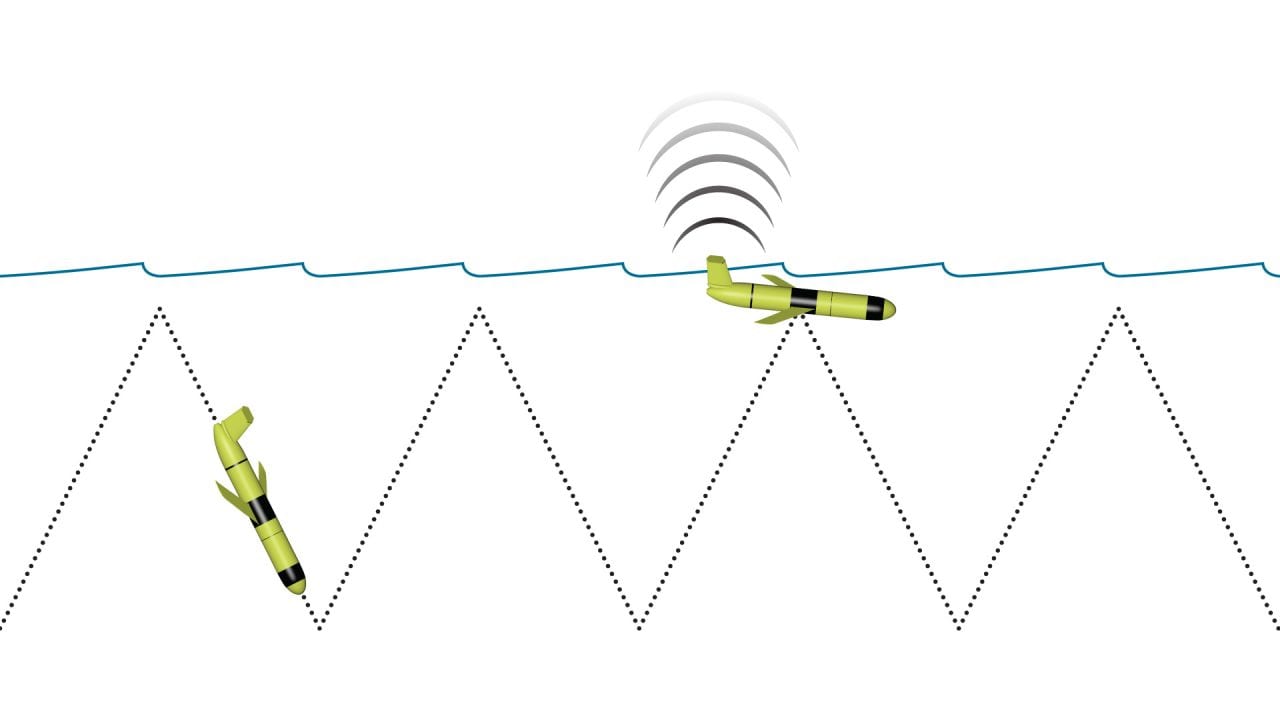
Slideshow
- An ocean glider has no propeller and moves up and down in the water by changing its buoyancy. A glider cannot receive or transmit data under water. It has to surface to get a GPS reading on its position and to exchange data with scientists back on shore. (Eric S. Taylor, WHOI Graphic Services)
- Gliders are often deployed into and recovered from the ocean after dark to allow time for other ship operations that require daylight. (Al Plueddemann, WHOI)
- Senior Engineering Assistant Tina Haskins and engineer Jared Schwartz work on a glider in the Laboratory for Ocean Sensors and Observing Systems at WHOI. Behind them is a tank used for “ballasting” gliders to ensure their buoyancy in the ocean. (Tom Kleindinst, WHOI)
Related Articles
- The little big picture
- Navigating new waters
- On the Move
- From Northern California to Ocean Engineer
- In the Ocean Twilight Zone, Life Remains a Mystery
- New glider design aims to expand access to ocean science
- Gift enables new investments in ocean technologies
- Can seismic data mules protect us from the next big one?
- Life at the Edge

